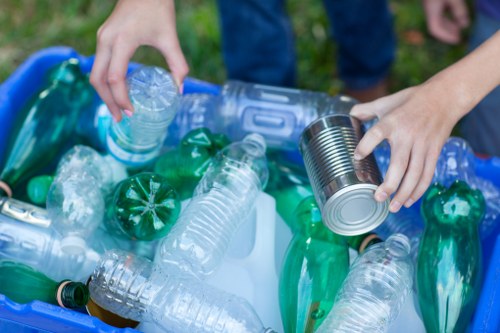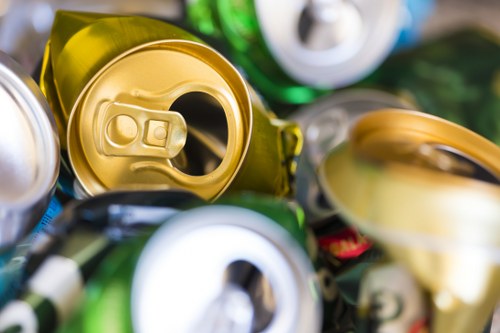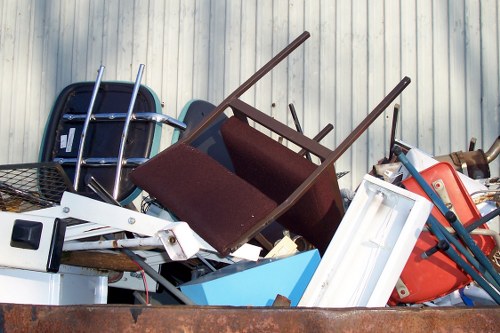Waste Removal in Rubbish Clearances
Understanding the Fundamentals of Waste Removal

Waste removal is an essential aspect of modern urban management and industrial operations. As cities grow and industrial waste increases, effective rubbish clearances have become critical to maintaining public health, environmental sustainability, and aesthetic appeal. In this evolving landscape, every step taken to improve waste management contributes to cleaner communities and a healthier planet. Companies and local authorities alike continue to innovate and update their practices in waste removal to adapt to new challenges and stricter environmental standards.
In recent years, the subject of waste removal within the sphere of rubbish clearances has attracted attention from a wide range of stakeholders. This includes municipal planners, environmentalists, logistics experts, and even community members. With the rising need for sustainability, the employment of efficient and environmentally friendly methods has become paramount. The industry now harnesses new technologies and creative operational strategies which aim to reduce landfill waste and enhance recycling practices universally.
Key components of modern rubbish clearances involve safety protocols, efficient collection routes, and proper waste segregation. Safety for teams on the ground, efficiency in scheduling pickups, and adherence to environmental guidelines form the backbone of an effective waste removal system. Businesses in this sector are adopting a holistic approach that combines technology with hard work and robust planning, ensuring that waste management is not only systematic but also sustainable.
Operational Strategies in Rubbish Clearances

The operational strategies in the field of waste removal revolve around the adoption of best practices, with critical emphasis on planning and logistics. Companies often start by analyzing waste streams, identifying key areas, and prioritizing regions with higher waste generation. This proactive planning allows for a more efficient allocation of resources and quicker turnaround times. In many cases, operators have integrated data-driven models to determine optimum routes for waste collection vehicles, thereby reducing costs and environmental impact.
Implementing a successful rubbish clearance system involves several layers of strategic planning that include route optimization, efficient load management, and a coordinated effort to meet local and federal guidelines. Effective waste removal systems are characterized by their scheduled collections and continuous monitoring of disposal facilities. Businesses in this sector employ various technological solutions such as GPS tracking and automated scheduling platforms to ensure the seamless conduct of their daily operations.
Moreover, these companies have developed a range of specialized services that cater to different types of waste. For instance, industrial waste requires a completely different handling process compared to residential rubbish. This versatility is often supported by tailored training programs for employees and continual upgrades in equipment, making waste removal operations both efficient and environmentally responsible. Utilizing these operational strategies ensures that rubbish clearances are executed with precision and care, ultimately benefiting the whole community.
Safety, Environmental, and Cost Considerations in Waste Removal

In the waste removal industry, safety is prioritized not only for the workers but also for the community at large. Through comprehensive risk assessments and active monitoring systems, companies ensure that all health and safety measures are stringently implemented. Protective gear, regular training sessions, and adherence to government regulations are central to these practices. There is a constant drive to innovate and employ new safety protocols that minimize exposure to hazardous materials and reduce work-related accidents.
Environmental considerations play a critical role in how waste management and rubbish clearances are planned. With escalating concerns about global warming and pollution, waste removal companies are investing in green technologies and sustainable practices. These include using energy-efficient vehicles, implementing advanced recycling technologies, and improving the overall waste segregation process. In many cases, these efforts not only protect the environment but also lower operational costs, creating a win-win situation for companies and the ecosystem alike.
Cost efficiency is another cornerstone of modern rubbish clearance operations. By optimizing routes and investing in smart technology, companies can reduce fuel consumption and labor costs. Implementing effective cost control measures without compromising safety or environmental standards is a challenge that industry experts actively address each day. The inclusion of strategies such as streamlined logistics and timely waste collection has been successful in reducing overall expenses while also managing significant waste volumes. The synergy between safety, environmental stewardship, and cost management continues to drive forward innovations in waste removal.
Innovative Techniques and Technologies in Waste Removal

The integration of innovative techniques and cutting-edge technology has revolutionized the field of rubbish clearances. Modern waste removal companies make use of advanced machinery and smart systems to improve efficiency. With the advent of automation and artificial intelligence, many operations now feature robotics that can sort and process waste with remarkable precision. This adoption of technological advancements not only streamlines operations but also significantly reduces manual labor costs and enhances worker safety.
As a part of their commitment to environmental sustainability, many companies have started to use renewable energy sources to power their operations. For example, solar-powered collection vehicles and recycling centers help reduce carbon emissions. Additionally, innovative sorting techniques allow for a more effective segregation of waste materials, making it easier to recycle or repurpose items. This progressive approach to waste removal highlights the importance of evolving with technological advancements and incorporating them into everyday operations.
Furthermore, the advent of smart waste management systems has allowed companies to monitor the quantity and type of waste produced in real time. Through the use of sensor-based technologies and data analytics, businesses can now fine-tune their operations to meet demand more effectively. Some companies even use real-time monitoring to schedule pickups and adjust routes dynamically, ensuring minimal downtime and maximum resource utilization. Adopting these innovative strategies reinforces the fact that the future of waste removal in rubbish clearances is both promising and environmentally vital.
Conclusion and Future Outlook in Waste Removal

In conclusion, waste removal in rubbish clearances stands as a critical element in modern waste management practices. From ensuring public safety and environmental protection to improving economic efficiency, the multi-faceted nature of the industry is evident in every facet of its operation. With continuous improvements in technology, operational planning, and environmental sustainability, the future of waste removal remains vibrant and full of potential. Communities across the globe are benefiting from innovations in rubbish clearances, which are setting new benchmarks for environmental stewardship and operational excellence.
Looking ahead, the field is expected to further integrate high-tech solutions and digital transformation processes. With the persistent focus on reducing carbon footprints and enhancing operational safety, companies are laying the groundwork for a greener and more sustainable future. The role of waste removal in urban planning and environmental management will only grow more significant, as governments and corporations work together to address the challenges of waste management on a global scale.
The journey towards better waste removal strategies has only just begun. Stakeholders from industry experts to local communities are encouraged to embrace these changes actively. Contact us today or Book your service now to experience efficient and expert rubbish clearance services. With the combined efforts of ever-evolving technology, robust operational strategies, and a collective commitment to a sustainable future, the landscape of waste removal is set to transform dramatically in the years to come.
Deep Dive into Waste Sorting Systems
The complexity of modern waste management is evident in its sorting systems, which play a critical role in the success of smart rubbish clearances. Detailed waste sorting is not only about classification but about ensuring that as much material as possible is recycled and repurposed. This involves a multi-step process where waste is initially segregated at the source, then further divided at processing facilities using state-of-the-art technologies.
Key advantages of advanced sorting systems include improved efficiency, reduced contamination levels, and economic benefits. Business owners and environmental specialists have noted that employing these systems results in higher quality recycled products. This outcome supports not only the sustainability of the individual business but also contributes to the broader goal of minimizing environmental degradation.
In addition to mechanical sorting, human oversight remains vital. Trained personnel continuously monitor the procedures to ensure precision. The blend of automated systems and human expertise yields remarkable improvements in the quality and quantity of materials that are recovered. The integration of digital tracking systems further enhances transparency, enabling a complete lifecycle analysis for every batch of waste cleared.
Embracing Eco-Friendly Technologies

One of the most significant trends in modern waste removal is the switch to eco-friendly technologies that guide rubbish clearances towards sustainability. Solar-powered machinery, electric waste collection vehicles, and renewable energy-driven processing plants are becoming mainstream worldwide. These technologies diminish reliance on fossil fuels, subsequently lowering greenhouse gas emissions. The investment in these systems, though initially high, promises long-term savings and environmental benefits that are essential for a greener future.
Furthermore, many waste management companies are actively researching and advancing the use of biodegradable materials and environmentally safe detergents for cleaning collection vehicles. This continuous effort to reduce the ecological footprint is a hallmark of progressive strategies in waste removal. The industry has seen substantial improvements in performance metrics and reliability due to the seamless integration of environmentally friendly solutions into daily operations.
Businesses that lead the market in waste removal often share a commitment to community outreach and educational initiatives. By raising awareness and engaging with local communities on the importance of recycling and proper waste disposal, these companies enhance their social responsibility and brand reputation. The development of interactive platforms and mobile applications further empowers residents to schedule pickups and track waste processing in real time, thus reinforcing transparency and trust.
Role of Government Regulations and Community Involvement

Government regulations play a pivotal role in shaping the landscape of waste removal in rubbish clearances. Strict environmental laws not only enforce proper waste management practices but also motivate companies to innovate and maintain high safety standards. Compliance with regulatory requirements is paramount, and waste management companies often exceed these baselines to set industry benchmarks.
Community involvement is another fundamental driver of successful waste removal practices. Active participation from citizens, in terms of segregating waste at home or at office premises, boosts the overall efficiency of clearance processes. Public education campaigns are organized frequently, emphasizing the importance of little actions that can lead to big environmental benefits. From community clean-ups to local workshops, these efforts play a crucial role in ensuring that waste removal strategies benefit all layers of society.
Many local authorities now collaborate with private firms to develop policies that enhance the waste removal ecosystem. These joint initiatives are aimed at improving processing capabilities and expanding recycling programs. A robust synergy between governmental bodies and private enterprises is vital for crafting a comprehensive approach to waste management that meets both environmental and economic objectives.
Economic Impact and Industry Growth

The economic impact of enhanced waste removal in rubbish clearances extends well beyond the immediate environment. The industry creates valuable jobs ranging from skilled labor to executive roles, promoting overall economic growth. Investments in technology, recycling plants, and sustainable operational processes have generated significant economic benefits, not just for the businesses involved but for entire regions.
Local economies thrive when waste removal companies adopt efficient practices. Reduced costs on waste management allow businesses to invest more in expanding their operations. Innovation in this sector is a key driver of growth, as improved processes lead to higher service quality and better environmental outcomes. Stakeholders are increasingly aware that robust waste management is an indispensable part of the economic framework of modern cities.
Moreover, several innovative financing models, including public-private partnerships, allow for sustainable investments in waste management infrastructure. This collaborative approach reduces the financial burden on governmental agencies and creates better-equipped communities. With such a dynamic economic landscape, the waste removal industry is set to expand further as new technologies and market opportunities emerge, ensuring that rubbish clearance remains a forward-thinking and essential sector.
Enhancing Public Awareness and Future Prospects
As waste removal practices continue to evolve, public awareness has become a cornerstone in the ongoing success of rubbish clearances. Educational initiatives and community programs are vital for changing the public's attitude toward waste. Through social media campaigns, local events, and interactive digital platforms, communities are informed about the benefits of efficient waste management practices.
It is increasingly recognized that every act of recycling and responsible waste disposal contributes to a larger environmental cause. Consumer participation is encouraged not only through incentive programs but also with easy-to-access information about waste segregation and disposal. This widespread public involvement is paving the way for innovative waste removal systems that benefit everyone involved.
Furthermore, academic institutions and research centers are continuously contributing to the field by developing groundbreaking methods for waste reprocessing. These research initiatives promote efficient resource utilization and offer insights into future directions for industry innovations. As technology and community practices converge, the future of waste removal in rubbish clearances looks both promising and transformative.
The ongoing commitment to sustainability, obtainable through enhanced waste management and community involvement, sets the stage for significant progress in environmental care. The era of wasteful practices is gradually giving way to a more conscientious society where every participant plays a role. In this evolving narrative, the importance of waste removal systems not only safeguards urban landscapes but also secures a cleaner, more sustainable future for generations to come.
Finally, the transformation witnessed in waste removal highlights a major milestone in modern urban management. The integration of efficient, cost-effective, and sustainable practices underscores the evolution of rubbish clearances. Stakeholders, whether private or public, continue to push the envelope of innovation while remaining steadfast in their commitment to environmental and community welfare. The journey of waste management redefines the responsibilities and rewards inherent to building resilient societies that thrive on progress and sustainability.